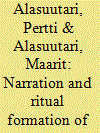| Srl | Item |
| 1 |
ID:
123133


|
|
|
|
|
| Publication |
2013.
|
| Summary/Abstract |
Scholars studying migration processes through the transnational prism have expanded the concept of 'diaspora' with a new meaning as a transnational, hybrid identity and condition, which has displaced the classical interpretation constructed around ethnicity and territory. By analyzing the activities of the Ukrainian Canadian Congress, which represents the organised Ukrainian community in Canada, an old-type diaspora, this paper argues that transnationality and hybridity have always been the inner attributes of diaspora identity and experience and stresses the importance of an essential characteristic of diaspora: the conscious effort to maintain a distinctive collective identity. Only if a community succeeds in maintaining its collective identity throughout multigenerational change can it qualify as a diaspora. These two dimensions - the self-consciousness of diaspora as a distinctive group and the survival of its distinctive identity through multigenerational change - set diasporas apart from transnational communities.
|
|
|
|
|
|
|
|
|
|
|
|
|
|
|
|
| 2 |
ID:
089209


|
|
|
|
|
| Publication |
2009.
|
| Summary/Abstract |
The article is based on a case study of second generation Karelian migrants, whose parents had to move to other parts of Finland from the region of Karelia that was ceded to the Soviet Union at the end of World War II. The article poses the question, how long-lived diasporic identities are, and what are the conditions that affect assimilation or maintenance of a diasporic identity. In the Karelian migrants' case, already the first generation was quite successful in integrating with the rest of the Finnish society, and with the second generation, the integration has been practically complete, largely because of a short cultural distance between the evacuees and other Finns. A recent resurgence of interest in their roots by Karelian evacuees or their family members is primarily due to end of the Cold War and the possibility to freely and openly visit Karelia. Visiting Karelia has a ritual-like function for them. To that concrete, bodily experience of going there they can attach the abstract idea that in some ways they are Karelians and thus strengthen the emotional attachment to their roots. In that sense, visiting Karelia can also be described as a pilgrimage.
|
|
|
|
|
|
|
|
|
|
|
|
|
|
|
|